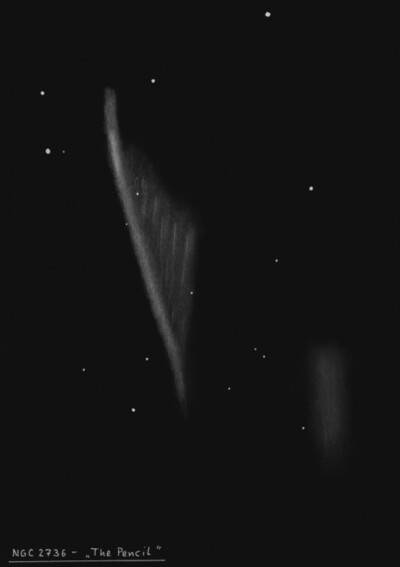Pencil Nebula
Pencil Nebula

John Herschel discovered NGC 2736 = h3145 on 1 Mar 1835 and recorded "eeF, L, vvmE; an extraordinary long narrow ray of excessively feeble light; position 19 deg±. At least 20' long, extending much beyond the limits of the field...". His position and sketch (Plate V, figure 12) agrees perfectly with ESO 260-N14, the brightest piece of the huge Vela SNR, centered ~ 5 degrees WNW.
Joseph Turner sketched NGC 2736 on 26 Jan 1876 using the Great Melbourne Telescope (plate IV, figure 34 at www.docdb.net/history/texts/1885osngmt________e/lithograph_m_4_34.php). Besides a thin ray, he also saw nebulosity spreading out from the southern end towards the west. In Jan 1885, Barachi commented, "Extremely faint, a long streak across the field, straight, very narrow, with a peculiar group of stars in the n.f. quadrant, forming almost a semicircle, of which the north portion of the streak is the diameter. Streak spreads out at its s.p. end, and becomes a large irregular-shaped whitishness, without distinct contour, which the eye cannot see except by moving the telescope up and down, and only when the back ground is perfectly black and free from haze; even then it requires a little time before it can be seen."
RNGC and NGC 2000.0 misclassify this filament as a galaxy and I mentioned this error in RNGC Corrections #5. The first reported connection of NGC 2736 with the Vela SNR was in 2000: http://www.journals.uchicago.edu/ApJ/journal/issues/ApJL/v543n2/005648/005648.html, two years after the discovery of the SNR itself in 1998. Estimated age of the supernova is 9-11,000 years.
300/350mm - 13.1" (2/18/04 - Costa Rica): Herschel's Ray was easily picked up at 105x using a UHC filter. It extended well over 1/2 of the 38' field, at least 20'x2', oriented SSW-NNE. This prominent Vela Supernova filament is brightest towards the NNE end near a mag 8.3 star which is just following the NNE edge. It appears like a thin splinter of light through the field with a weak filamentary structure and variations in brightness, similar to one of the fainter filaments in the Veil nebula. Several stars are very close to the edge including a mag 11 star near the middle. I was impressed the appearance was very comparable to the view I had through the 18-inch in Australia.
400/500mm - 18" (7/7/02 - Magellan Observatory, Australia): this is an isolated bright eastern filament in the Vela Supernova remnant which is centered over 4° to the west. At 128x and UHC filter (38 arcmin field), it appears as a fairly faint, thin, nebulous streak extending SSW-NNE over half the field, ~20'x1'! The surface brightness is roughly uniform, though the northern portion is brighter near a mag 8.3 star off the NE end. The nebulosity continues past this star and ends with a mag 9.5 star due east of the NNE tip. On the SSW end the nebulosity gradually dims out. A few mag 11 stars border the filament, one just off the west edge near the center and a couple further south.
600/800mm - 24" (4/11/08 - Magellan Observatory, Australia): Herschel's Ray was a striking, bright filament at 130x and a UHC or OIII filter, extending SSW-NNE for at least 20' in length. Herschel's Ray is brightest along a 5' stretch at the NNE end as it passes to the west of mag 8.3 HD 774433 and continues NNE ending to the west of a mag 9.5 star. Several very faint stars appear to very close to the northern half of the ray, particularly along the eastern edge, though a mag 11.2 star is also at the western edge. The ray weakens or thins to a narrow splinter just the east of this mag 11.2 star. At the NNE tip the filament subtly bends very slightly towards the north and at the SSW end the filament more obviously curves or hooks slightly towards the south as it fades.
Notes by Steve Gottlieb